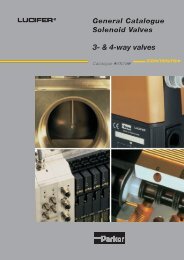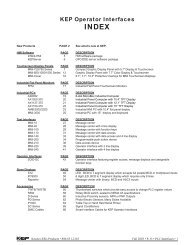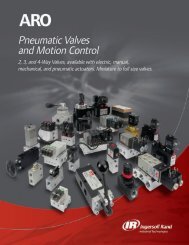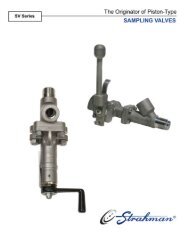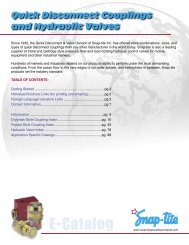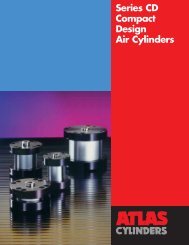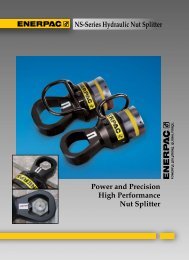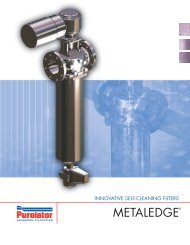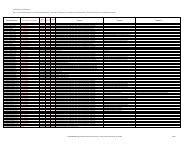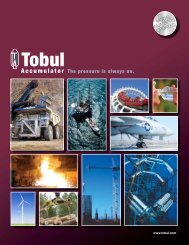Pneumatic Cylinders - Norman Equipment Co.
Pneumatic Cylinders - Norman Equipment Co.
Pneumatic Cylinders - Norman Equipment Co.
Create successful ePaper yourself
Turn your PDF publications into a flip-book with our unique Google optimized e-Paper software.
<strong>Pneumatic</strong> <strong>Cylinders</strong>Silverair FeaturesSeries S (Hall Effect Switches)Hall Effect Sensors are typically used in conjunction with computers,programmable controllers or other solid state devices to sense andprocess cylinder rod proximity. The solid state circuitry in this sinkingswitch (NPN) provides clean, fast output without “bounce.” The 300mW power capability restricts its use to low power loads. One switchkit fits all Silverair cylinders for reduced and simplified inventory. 3/8inch effective area per switch. For two switches, a minimum of 1-inchstroke is recommended.Series S (Reed Switches)Epoxy encapsulated reed switches are ideal for harsh environments.One switch kit fits all Silverair cylinders for reduced and simplifiedinventory. 50 watt reed is common in all sensors. Model 117045-300lights up during reed engagement in low voltage applications. Model117045-500 lights up over wide voltage range. Model 117045-100 is abasic sensor with no LED.Performance SpecificationsSeries S (Hall Effect Switches)Input Voltage:5 to 24 VDCInput Current:25 mA maximumOutput Voltage Drop:0.4 VDC maximumOutput Current:330 mA maximumPower Dissipation:300 mW maximumTemperature Range:-20° to 185°F (-29° to 85°C)Series S (Reed Switches)<strong>Co</strong>ntacts:Normally open<strong>Co</strong>ntact Rating:50 W maximumSwitching Current:1 A maximumInitial <strong>Co</strong>ntact Resistance: 1 OhmMinimum Break Down Voltage: 225 VDC, 275 VACTemperature Range:-40° to 200°F (-40° to 93°C)Technical Information:1. Do not exceed specification, permanent damage to the sensor mayoccur.2. For reed switch type sensors, polarity must be observed for theproper functioning of LED. <strong>Co</strong>nnect the brown wire in series with loadpositive (+) and the blue wire to negative (-) or power source space.If the polarity is reversed, reed switch remains functional but LED willremain in “OFF” state.3. For solid-state type sensors, polarity must also be observed. <strong>Co</strong>nnectbrown wire to the positive (+) and the blue to the negative (-) of DCpower source. The black wire must connect to the load ONLY. If theblack wire is accidentally connected to the power source, permanentdamage to the sensor may occur.4. An external protection circuit may be required if the reed switch isused with inductive load, such as relay or solenoid. For DC inductiveload, attach an external diode parallel to the load and use R -C circuitparallel with AC inductive load.5. Keep sensors away from stray magnetic field to prevent malfunctions.6. When using reed switch with capacitive load or if the lead wire lengthexceeds 10-meter, and inductor must be installed in series with thesensor to prevent damage (Sticking effect).OrderingSeries S (Hall Effect Switches)Model No. Description118123-100 w/LED, 5-24 VDC, 24 inch leads (includes 118124 Mounting Kit)118123-200 w/LED, 5-24 VDC, 144 inch leads (includes 118124 Mounting Kit)Series S (Reed Switches)One 118124 Mounting Kit is included with each Reed SwitchModel No. Description117045-100 No LED, 120 VAC or 200 VDC max., 24 inch leads117045-200 No LED, 120 VAC or 200 VDC max., 144 inch leads117045-300 w/LED, 5-24 VAC/DC max., 24 inch leads117045-400 w/LED, 5-24 VAC/DC max., 144 inch leads117045-500 w/LED, 120 VAC or 200 VDC max., 24 inch leads117045-600 w/LED, 120 VAC or 200 VDC max., 144 inch leads23



